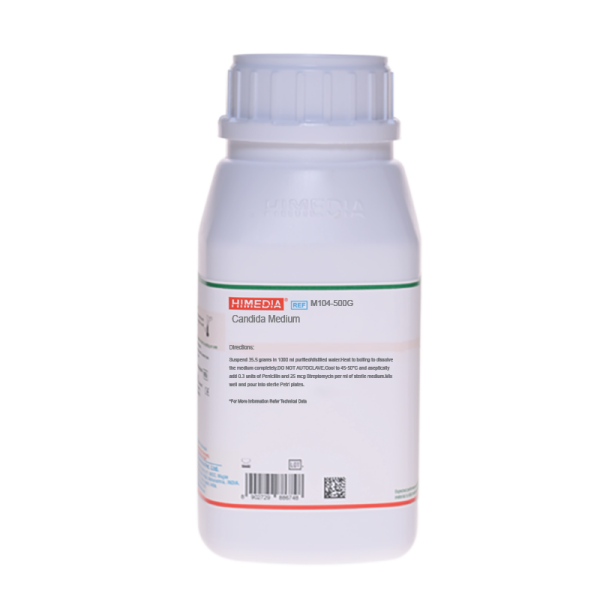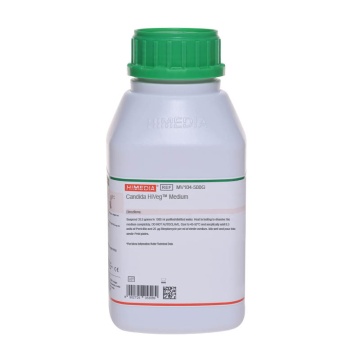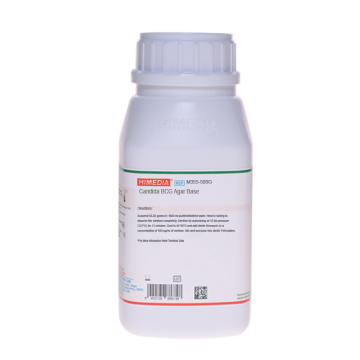 Your enquiry has been submitted
Your enquiry has been submitted
Candida Medium
Intended Use
Recommended for selective isolation and cultivation of Candida species from clinical and non-clinical samples.
Composition
| Ingredients | g/L |
|---|---|
| Mycological peptone | 2.500 |
| Dextrose (Glucose) | 5.000 |
| Disodium hydrogen phosphate | 5.000 |
| Sodium sulphite | 5.000 |
| Bismuth sulphite indicator | 3.000 |
| Agar | 15.000 |
Final pH (at 25°C): 7.6±0.2
Formula adjusted, standardized to suit performance parameters
Directions
Suspend 35.5 grams in 1000 ml purified/distilled water. Heat to boiling to dissolve the medium completely. DO NOT AUTOCLAVE. Cool to 45-50°C and aseptically add 0.3 units of Penicillin and 25 mcg Streptomycin per ml of sterile medium. Mix well and pour into sterile Petri plates.
Principle And Interpretation
Candida is a genus of yeasts responsible for infections such as osopharyngeal candidiasis, vaginal candidiasis and candidemia. Candida Medium is used for the selective cultivation and differentiation of Candida species. Candida Medium was originally developed by Nickerson (1). It is also used for processing and inoculation of specimens like tissues, skin scrapping, nails and hair (2,3).
Mycological peptone in the medium provides essential nitrogenous nutrients while dextrose acts as carbon source and phosphate maintains buffering action of medium. This medium also contains sodium sulphite, which is reduced by Candida species to form sulphide. Bismuth in the medium combines with the sulphide to produce brown to black pigmented colonies and zones of dark precipitate in the medium surrounding the colonies of some species. Bismuth sulphite also acts as an inhibitor of bacterial growth. Selectivity of medium is increased by incorporation of penicillin and streptomycin in the medium, which helps to suppress the growth of many bacteria.
Differentiation of Candida is based on the growth patterns and pigmentation of isolated colonies.
Type of specimen
Clinical samples - skin scrapping, nails and hair
Specimen Collection and Handling
For clinical samples follow appropriate techniques for handling specimens as per established guidelines (4,5).
After use, contaminated materials must be sterilized by autoclaving before discarding.
Warning and Precautions
In Vitro diagnostic Use only. For professional use only. Read the label before opening the container. Wear protective gloves/protective clothing/eye protection/ face protection. Follow good microbiological lab practices while handling specimens and culture. Standard precautions as per established guidelines should be followed while handling clinical specimens. Safety guidelines may be referred in individual safety data sheets.
Limitations
- This medium is general purpose medium and may not support the growth of fastidious organisms.
Performance and Evaluation
Performance of the medium is expected when used as per the direction on the label within the expiry period when stored at recommended temperature.
Quality Control
Appearance Cream to yellow homogeneous free flowing powder
Gelling Firm, comparable with 1.5% Agar gel
Colour and Clarity of prepared medium Light yellow coloured, clear to slightly opalescent gel forms in Petri plates
Reaction Reaction of 3.55% w/v aqueous solution at 25°C. pH: 7.6±0.2
pH 7.40-7.80
Cultural Response
Cultural characteristics observed after an incubation at 30°C for 24-48 hours.
| Organism | Inoculum (CFU) | Growth | Recovery |
|---|---|---|---|
| Candida albicans ATCC 10231 (00054*) | 50-100 | good-luxuriant | >=50% |
| Candida tropicalis ATCC 1369 | 50-100 | good-luxuriant | >=50% |
| Escherichia coli ATCC 25922 (00013*) | >=104 | inhibited | 0% |
Key: *Corresponding WDCM numbers.
Storage and Shelf Life
Store between 10-30°C in a tightly closed container and the prepared medium at 20-30°C. Use before expiry date on the label. On opening, product should be properly stored dry, after tightly capping the bottle in order to prevent lump formation due to the hygroscopic nature of the product. Improper storage of the product may lead to lump formation. Store in dry ventilated area protected from extremes of temperature and sources of ignition. Seal the container tightly after use. Product performance is best if used within stated expiry period.
Disposal
User must ensure safe disposal by autoclaving and/or incineration of used or unusable preparations of this product. Follow established laboratory procedures in disposing of infectious materials and material that comes into contact with clinical sample must be decontaminated and disposed of in accordance with current laboratory techniques (4,5).
Reference
- Nickerson, 1953, J. Infect. Dis., 93:43.
- Emmons, Binford, Utz and Kwon-Chung, 1977, Medical Mycology, 3rd Ed., W. B. Saunders Co., Philadelphia.
- Haley, Trandel and Coyle, 1980, Cumitech 11, Practical Methods for Culture and Identification Of Fungi In The Clinical Mycology Laboratory, Coord Ed., Sherris, ASM, Washington, D.C.
- Isenberg, H.D. Clinical Microbiology Procedures Handbook 2nd Edition.
- Jorgensen, J.H., Pfaller, M.A., Carroll, K.C., Funke, G., Landry, M.L., Richter, S.S and Warnock., D.W. (2015) Manual of Clinical Microbiology, 11th Edition. Vol. 1.
| Product Name | Candida Medium |
|---|---|
| SKU | M104 |
| Product Type | Regular |
| Physical Form | Powder |
| Origin | Animal |
| Packaging type | HDPE |
| References | 1. Nickerson, 1953, J. Infect. Dis., 93:43. 2.Haley, Trandel and Coyle, 1980, Cumitech 11, Practical Methods for Culture and Identification Of Fungi In The ClinicalMycology Laboratory, Coord Ed., Sherris, ASM, Washington, D.C. 3.Emmons, Binford, Utz and Kwon-Chung, 1977, Medical Mycology, 3rd Ed. , W. B. Saunders Co., Philadelphia. |
| Customized Product Available | No |








